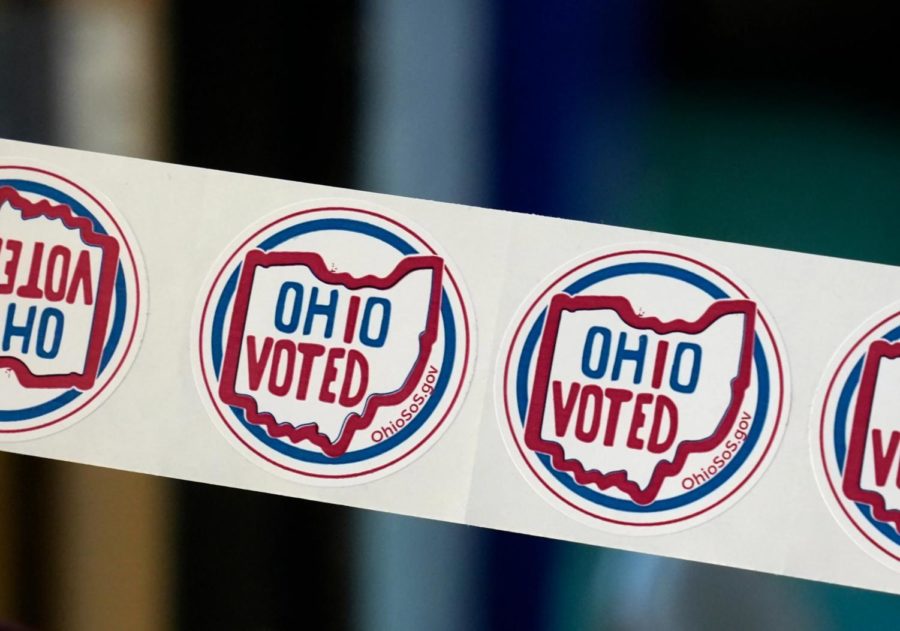How new Ohio voting laws impact CWRU students
Courtesy of Barbara Perenic/Columbus Dispatch
This past January, Ohio Governer Mike DeWine signed House Bill 458 into action, changing Ohio’s voter ID laws and impacting many CWRU students’ ability to vote.
April 7, 2023
On Jan. 6, 2023, Ohio Governor Mike DeWine signed House Bill 458, which originally intended to eliminate August special elections in Ohio. After going through the Republican-controlled Ohio Legislature, it later morphed into an overhaul of Ohio’s voter ID laws and timelines.
Previously, all one had to do in order to vote in Ohio was prove an Ohio address. For Case Western Reserve University students, this normally meant printing a residency verification from the MyHousing website, or presenting a bank statement or utility bill.
Yet, as Democracy Fellow for Campus Votes and leader for CWRUVotes Sabrina Wicker notes, “Ohio has the strictest voter ID laws in the nation. Beyond military ID, you can only use an Ohio state ID, Ohio driver’s license or a federal passport.”
She went on to explain, “Now, instead of being so focused on ‘Are you registered at the right place; is it where you currently live’ now they [ask] ‘Are you the actual person who is voting?’”
Wicker also notes that 80% of CWRU’s student population are not from the state of Ohio, thus obtaining an Ohio state ID might not be super feasible for most students. According to Rob Nichols, press secretary of the Ohio Department of State—the office that oversees elections—if a student from Pennsylvania, for example, “[Has] a Pennsylvania license, wants to vote in Ohio, and goes get an Ohio license or state ID, it invalidates their home life” as it is a “Federal law that you can not hold two drivers licenses.”
“It’s always been a choice a college student has to make regarding to vote in their home state absentee…or whether they are going to vote in Ohio,” Nichols mentions about the dilemma now facing students.
Both Wicker and Nichols agree on a common workaround to showing ID at the polling place: voting absentee, as “you are not required to provide a driver’s license or state ID card” as you instead provide the last four digits of your social security number.
“This campus does not have a polling location. You have to go to the Board of Elections and navigate the voter ID laws, knowing most students have an Ohio state ID or driver’s license, so the easiest way to vote is absentee,” states Wicker. “We also always recommend absentee [ballots] for very busy college students…you take the time, sit with your ballot and do your research.”
HB 458 further changed the deadline for absentee voting: Now a voter must request their absentee ballot earlier, and it only has four days after election day to arrive at the Board of Elections. Rob explains that this change was instituted by the legislature “As people were inadvertently disenfranchising themselves as they try to do all these mail procedures too close to election day.” Further, on the last day of early voting, Monday’s hours have been distributed to other days, curtailing available voting hours.
In the runup to passing HB 458, many supporters of the bill claimed that it would make voting in Ohio safer, and that it is a popular change. Nichols stated, “Voter ID law is supported by the overwhelming majority of Ohioans. People believe, in Ohio, that you should have to prove who you are to vote.”
Yet, Representative Darnell T. Brewer (D-18), whose district covers part of CWRU, noted that now, “Voter suppression is real in Ohio! They know the value of your voice and vote.” He considered HB 458 to be a general attack against higher education in Ohio, connecting it to SB 83, which seeks to regulate universities. “HB 458 was just the beginning. SB 83 is just another attack on Ohio universities, its students and faculty and is cold-hearted.”
Brewer hopes that “college students, especially in the Cleveland/Cuyahoga County area, research, take action and come and voice their concerns during the process.”
At CWRU, one of the main offices responding to this change is the Center for Civic Engagement and Learning (CCEL). Rachel VanArsdale, a coordinator at CCEL, noted “We are using the information we’ve gained to update all of CCEL’s voting resources.” This includes updating CCEL’s “Elections and Voter Resources” website, new training for CWRUVotes and “beginning outreach to student organizations to provide educational sessions around the new legislation.”
Once Election Day rolls around, VanArsdale notes that CCEL will still focus on “three areas of the voting process: voter registration, voter education and voter turnout.” She reminds students that the CCEL office still has all the various forms, absentee ballot requests and various graphics of the changing laws.
“We’ll continue to provide voter registration tables, voter education sessions, and transportation for voting early in-person and on Election Day to make it easier for student voters to get to the polls. We additionally plan to expand our programming about vote-by-mail by hosting events for students to complete absentee ballot request forms and taking trips to the Cuyahoga County Board of Elections for students to drop off their absentee ballots,” VanArsdale noted about the voting resources at CWRU.



